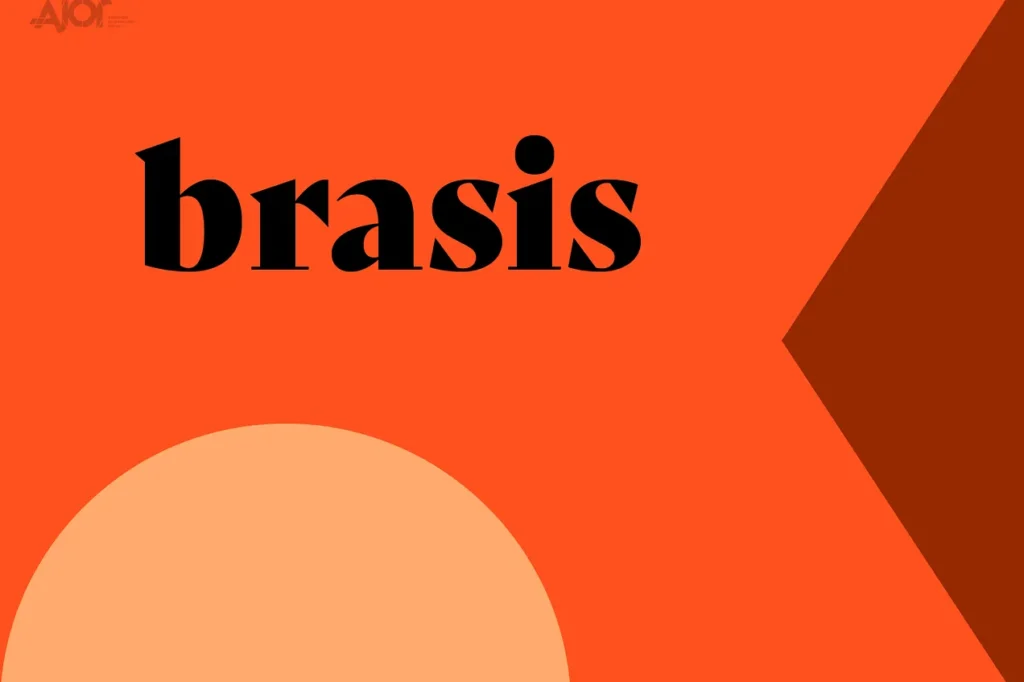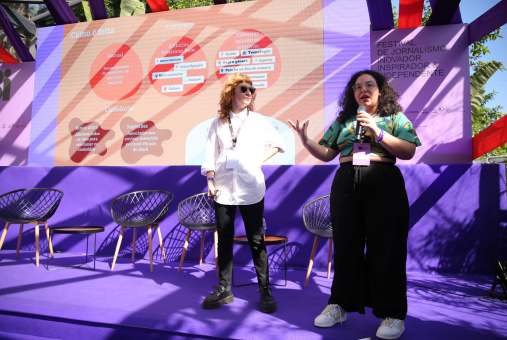Faced with the unprecedented drought that consumed rivers in the Amazon, a boatman hoisted on his shoulders the river-dwelling children he transports to school every day. The article published by the site Amazônia Latitude shows the human impact of the climate emergency and was one of the highlights of the Brasis newsletter at the beginning of October.
“This is the story, this is the Brazilian who is building the country,” Audrey Furlaneto, editor of Brasis, told LatAm Journalism Review (LJR) about what she thought when she read the story of the boatman and the children of Santarém, in Pará, northern Brazil.
Local journalism stories that echo national and even global issues are shared daily via Brasis. The curated newsletter was launched two years ago by Brazil’s Digital Journalism Association (Ajor, for its initials in English) to publicize the content produced by its members.

The Brasis newsletter was launched by Ajor in September 2022. (Image: Ajor)
Furlaneto said she was part of creating this journalistic product that reaches subscribers from Monday to Friday, with samples of the work of the 157 digital native media outlets that belong to Ajor.
“The idea, when we started, was to show that Brazilian digital journalism is producing content, and quality content, that we don’t see in traditional media,” she said.
Brasis shows the different approaches from these digital media outlets to topics covered in the national news. But it also shares local coverage and coverage of topics in which some of these media outlets specialize, such as environmental, gender and racial issues, which do not always receive proper attention in traditional media outlets.
“We look for new angles: when everyone is talking about the election, let's talk about the election of Quilombola people or look at LGBT candidacies,” Furlaneto said. “We always have this view of what is happening in the country right now and how we can look at [Ajor] members and get their perspectives on it.”
Furlaneto and Tainah Ramos, communications analyst at Ajor, produce Brasis. They review digital media websites and try to access all of them daily – which is not always possible, Furlaneto said. Furthermore, they have a Slack channel for Ajor members to send their recommendations for the newsletter.
Brasis was launched in September 2022 and initially sent to an Ajor email base that contained around 4,000 people. Today, the newsletter has 7,410 subscribers and an open rate of 29%, Furlaneto said.
In the two years since, the team that produces the newsletter carried out two satisfaction surveys with subscribers. The most recent, carried out between February and March this year, received responses from 158 people. More than half (55%) said they started following a digital media outlet that they discovered through Brasis. The most cited was Nonada, based in Porto Alegre, Rio Grande do Sul, which covers culture with a focus on cultural policies, traditional communities, popular cultures and memory and heritage.
Thaís Seganfredo, director of journalism and editor of Nonada, told LJR that every morning she reads Brasis and some traditional Brazilian newspapers. She said there is a complementary relationship between the content of digital natives published in Brasis and what can be found in the mainstream press.
“Many very important facts about the country are not covered by traditional journalism and are there in Brasis,” Seganfredo said.

Audrey Furlaneto, editor of Brasis, and Tainah Ramos, communications analyst at Ajor, during the 3i Festival 2023. (Photo: Heros Cegatta / Ajor)
In this sense, Furlaneto said the newsletter is “a wealth of story ideas” for journalists who work in traditional media. She herself has a history of working in large newsrooms as she started her career at Folha de S.Paulo at the age of 20, also worked at O Globo and collaborated with the newspaper Valor Econômico and the magazines piauí and the now-extinct Época.
“When you are in the newsroom on a daily basis, you look at your competitors, at the mainstream press. When I went to Brasis, I thought if I had known before there was such a large ecosystem, I would have benefited a lot from it, not only to get story ideas but to have a different look at things,” Furlaneto said.
She said she heard from journalist friends that Brasis helped them find sources for their reporting on local contexts that were far away.
“For example, someone was covering a drought and couldn’t find anyone to interview. And then he got in touch with a local media outlet that was in Brasis and got the contact of a resident. Local journalism in this sense has a lot to teach and offer journalists in the mainstream press. It could be a very interesting path of exchange,” Furlaneto said.
Seganfredo highlighted, however, that it is common for digital native media to provide story ideas, directly or indirectly, to traditional media and not receive any recognition for this.
“I would think it would be great if traditional media outlets started to value more what digital journalism brings and increasingly give credit to what these organizations do with such quality, as we have seen at Brasis,” she said.
In addition to bringing more readers to Nonada, Brasis also had a more “subjective” impact for the media outlet, Seganfredo said. “I know that Nonada has become better known among representatives of third sector organizations, an audience we are very interested in talking to,” she said.
Seganfredo also noted that being in Brasis means Nonada is republished more by other media outlets.
“Nonada has an open license, and all of our stories can be replicated on the websites of other outlets in full. I've sometimes seen our articles replicated by other outlets on the same day or the next day they appeared in Brasis. For us, this is very important, because it amplifies and echoes our journalism,” she said.
Furlaneto said that the content released by Brasis that received the most clicks to date was the report “On the other side of the screen: Why young people from the peripheries entered the online adult content market,” published in April 2024 by Agência Mural, which makes journalism about areas in the periphery regions.
In addition to the clicks on this article, 10% of subscribers to Mural Inbox, the agency's newsletter, came from Brasis, Anderson Meneses, director of technology and business at Mural, told LJR. These subscribers came through a recommendation from Substack, the platform used by both newsletters.
Meneses said that he follows Brasis daily and that the greatest value he sees in the newsletter, compared to bulletins from traditional media, is the plurality of perspectives offered.
“Brasis brings multiple perspectives. It has an editorial line, let's say, that of Ajor, but it combines different editorial lines from so many different perspectives in Brazil, and brings very different perspectives from a Grupo Globo or a Grupo Folha,” Meneses said, in reference to two large communication groups in the country. “The plurality of Brazil is being created by the various hands and the various perspectives of people who are in different territories of Brazil.”
Suzana Barbosa, a journalism professor at the Federal University of Bahia (UFBA) who researches communication and digital culture, told LJR she is a regular reader of Brasis and that she values the diversity offered by the newsletter.
“I always tell students that [Brasis] is a sample of both thematic diversity, due to the characteristics of the media associated with Ajor, and the regional diversity of Brazil. This breadth may not exist elsewhere,” she said.
The professor highlighted, however, that she sees the newsletter from the perspective of a journalism professional and researcher on the topic, and that she does not know whether people who subscribe to Brasis have the tools to assess the relevance of this diversity. The newsletter, she said, breaks information bubbles by offering alternatives to traditional media.
“Unfortunately, we know that not everyone seeks to diversify their sources of information. And this is a loss, it is a huge loss for the development not only of readers, but for people's lives, to know that there is more than what is offered in the hegemonic world of [journalism] brands,” Barbosa said.
Furlaneto said that in the last two years there hasn’t been a major publicity campaign for Brasis other than posts on Ajor's profiles on social networks. She said the next step to help disseminate the newsletter will be to share it among journalism students and colleges.
“We want to show those who are graduating – and this is also one of Brasis' missions – that there is work outside of traditional media. That we can look at local outlets, in our own communities, and see the potential for work there,” Furlaneto said. “I'm from the generation that left college and was going to try to become trainees at Folha or Estadão. Today you can look for an outlet in your community and do an excellent job.”